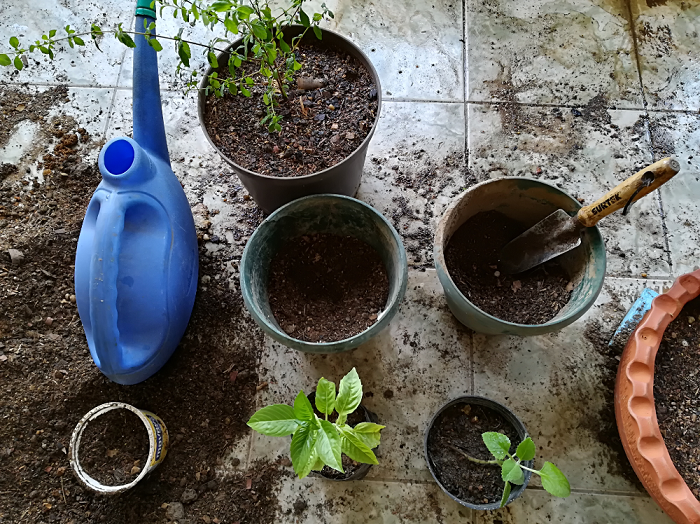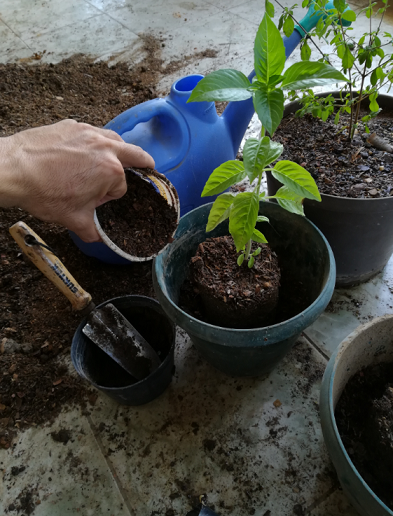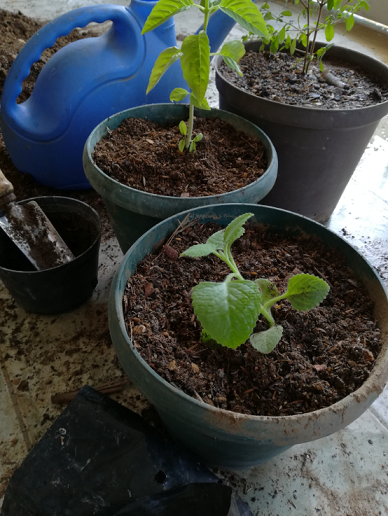[Gardening]: Transplants of Basil and Oregano in the garden!
TRANSPLANTS IN THE GARDEN:
Transplantation is one of the most important annual activities in our garden. There are many cases in which our plants can be presented as signs of weakness or disease, all without noticing the attack of the plague or disease, until, crossed hands we have to see her die, well, we do not know what to do.
There are many people who tell me that the plants have loss of foliage, yellowing of their leaves, the development of new shoots or even the reduction of the size of the leaves, as occurs with the bonsai. I also have many who tell me that at the time of watering their potted plants, which is a lot of time waiting for the water to drain and is notorious a puddle or formation of a water well on the surface. This is the best indicator that your plant needs an URGENT transplant.
A waterlogging in the substrate of our plants would be similar to that of our shoes and we go out every day on foot, it is sure that we will receive a fungal attack on our feet. In plants this will occur in their roots and that problem that is not seen unless we remove the substrate, it will be reflected in the foliage of our plant, that is why we need a very clean substrate, which allows aeration to the roots and space for the development of adventitious roots or rootlets, which will use our plant to feed. But this is not the only problem we can achieve, also the lack of space in the substrate or better said in the pot, interfering in the growth of the roots of our plant and causing serious problems, which are corrected by transplanting.
Another reason to perform a transplant is to change the pot for a bigger or more beautiful one, in the case of bonsai it can be to change the pot of a bigger one (normally they are used for the development of the branch) to small (may be your bonsai pot).

Today I am going to carry out the transplant of several seedlings, some were acquired in the nursery days before and others I received as a gift already in a small pot. I like to have this type of plant in my garden because, there is nothing better than watching them grow, cultivate them organically and use them as a dressing at the time of cooking or as a base for some infusion.
But before explaining the transplant and the function of each plant in my garden, I want to make a brief summary about the preparation of the substrate, because there is not a single substrate for all the plants, we must prepare it mixing according to the need of our plants and according to the climatic conditions of the area where we live.
PREPARATION OF THE SUBSTRATE
First of all we must acquire the compost, that will be our base and the source of organic matter in the substrate, this compost I got in the nursery, there they call it "mountain land", but it's a mixture of rice husk, coffee husk, river sand and a part of black earth, all this is mixed and left to decompose for 6 months by applying water and stirring every day, they also apply some chicken dung and live microorganisms, known in my region as efficient microorganisms (yeast, mycorrhizae, lactobasilos, etc).

Then to this compost is added a part of fine gravel (known as boulder in my city) and sand that can be construction or river sand (I recommend this to have minerals), these two materials will contribute the porosity to the substrate so that it has a good drainage and although it does not seem to help moisture moisture in the substrate due to the capillary effect.

You can add other materials such as hummus of solid worm or bocashi, also agricultural lime to control the acidity or ash to incorporate minerals, but I prefer to apply it at another time, because I consider that my compost was quite enriched with organic matter.

Once the material is added, everything is mixed and a Trichoderma is applied to disinfect our substrate of harmful microorganisms. It will also be produced in the substrate and begin to interact beneficially in the roots of our plant, stimulating growth and improving the absorption of nutrients.
The proportion of the mixture will depend on the demand of the plant, there are plants that like very humid soil, others like dry soils, this must be taken into account analyzing the climatic conditions of your region. If it rains a lot and it is cold you should lean to use floors with less organic matter and more gravel, to provide good drainage. In my city it is very hot and breezy to be near the beach, therefore I use a greater amount of compost (approximately 50% of the mixture), 25% of gravel and 25% of sand.
Today I will only perform four transplants, one Basil, one Oregano Orejon (in this publication) and another publication a green Oregano also known as dwarf Oregano in my city and a coffee plant variety Colombia 27, which I wanted to have to decorate my garden.
TRANSPLANTING MY BASIL (Ocimum basilicum)
This Basil (Ocimum basilicum) is an aromatic plant which I personally love in the kitchen, this was acquired a few weeks earlier in the nursery, at the time of purchase it came in a black growth bag, but I wanted to pass it to a large plastic container so that it develops in less time. Here you will possibly spend about two years where you will develop your root system and its foliage, then I will think about passing it to a bigger pot.
Basil in the garden provides many benefits, such as helping to fight or repel attacks of pests in the garden, such as whitefly, aphids or mosquitoes, something we all want at the time of organic farming. It also fights some fungi.

Basil is a plant that lasts little, Normally after the flowering dies, that is why we want the plant to stay longer in our garden, which we try not to flower. But this plant can reproduce it easily by seeds or cuttings, So, once our first plant is acquired, we can maintain the crop in our garden.

Basil is a plant that loves the sun, so we must place it in a place where it receives the most light hours per day, preferably the morning and afternoon sun. It also likes moisture, but without waterlogging, which is why we must water it frequently but we must use a well-drained substrate.
This plant can be easily associated with other plants such as pimentos, tomatoes, cucumber, zucchini, in my case I have peppers in my garden, so it will be a good ally.

This plant did not suffer stress at the time of the transplant, because it tries as much as possible not to touch its roots, in a few days the accelerated start of its growth will be observed. In case you have touched the roots or see stress in the plant you can sprinkle a foliage with a little sugar water, this will help to quickly recover our plants.
OREJON OREGANO TRANSPLANTATION (Origanum vulgare)
The Oregano orejon (Origanum vulgare) is another plant that should not be missing in your garden, this is an aromatic and medicinal plant of Mediterranean origin and from which its leaves and floral apices are used, this plant is used to prepare infusions, can has various medicinal properties such as:
-It has entioxidant and antiseptic properties.
-Controlled the sugar in the blood.
-Improves blood circulation.
-It's an expectorant.
-Sana scabies, etc.
Some people give it culinary use and it is very appreciated gastronomically as a condiment, although I personally prefer the taste of the dwarf oregano, which is another variety and which I will be talking about later.

The oregano oregano is very easy to grow in the garden, I believe that this is why it is not missing in the house of any grandmother in my country. He loves direct sun, but he likes to have some humidity in his roots, so we will try not to let him spend long periods without receiving water.

Oregano is also used as an ant-repellent, you can use it as an infusion, then filter it and apply it to a sprinkler. It is also widely used in aromatherapy and perfumes.

For both plants I will use foliar fertilizer of earthworm hummus, but when the plants show growth, which would indicate the beginning of their growth cycle, if you observe symptoms of disease, do not apply fertilizer, it would be worse. With this photograph I finish my publication, inviting you to read HERE! my publication about a transplant of potted paprika seedlings. Tomorrow I will be publishing the transplant of a dwarf Oregano and a coffee plant that germinated at home. No more to add, I encourage you to make your own gardens and I wish you a happy and blessed day!

Terrific, well written and in depth post explaining the fundamentals of transplanting. Thanks for sharing! I've started writing my own gardening posts on my experiences growing vegetables on my terrace. Would love to know what you think. Looking forward to Spring! :-)
Seguire tips de esta publicación para mis bonsai!
Bien! estoy por subir un paso a paso de trabajos de bonsai
Excelente, estaré al pendiente:)
Uh huh. Making all of us other gardeners look bad when you do something like this. You really spoil your plants with the good stuff, don't you? That soil blend looks incredible.
hehehe thank you @creative! I enjoy working in the garden (although I do not have much space), then I upload a photo of my terrace, apart from the aromatic, medicinal and bonsai plants I have a hive of bees that help me with pollination. Do you use discordapp.com?
Yes I am on discord when I'm at home. Glad you make the best of your space. That soil looks like chocolate cocoa to me.
I'm watching your publications!
You got a 7.13% upvote from @mercurybot courtesy of @daniellozada!
You got a 1.11% upvote from @postpromoter courtesy of @daniellozada!
Want to promote your posts too? Check out the Steem Bot Tracker website for more info. If you would like to support the development of @postpromoter and the bot tracker please vote for @yabapmatt for witness!
This post has received a 1.25% upvote from thanks to: @daniellozada.
thanks to: @daniellozada.
For more information, click here!!!!
Send minimum 0.010 SBD|STEEM to bid for votes.
Do you know, you can also earn daily passive income simply by delegating your Steem Power to @minnowhelper by clicking following links: 10SP, 100SP, 500SP, 1000SP or Another amount
Great article. beautiful plant !